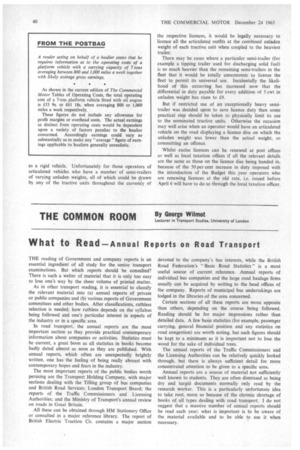What to Read—Annual Re ports on Road Transport
Page 42

If you've noticed an error in this article please click here to report it so we can fix it.
THE reading of Government and company reports is an essential ingredient of all study for the senior transport examinations. But which reports should be consulted? There is such a welter of material that it is only too easy to lose one's way by the sheer volume of printed matter.
As in other transport reading, it is essential to classify the relevant material into (a) annual reports of private or public companies and (b) various reports of Government committees and other bodies. After classifications, ruthless selection is needed; how ruthless depends on the syllabus being followed and one's particular interest in aspects of the industry or in a specific area.
In road transport, the annual reports are the most important section as they provide practical contemporary information about companies or activities. Statistics must be current, a great boon as all statistics in books become badly dated almost as soon as they are published. With annual reports, which often are unexpectedly brightly written. one has the feeling of being really abreast with contemporary hopes and fears in the industry.
The most important reports of the public bodies worth perusing are the Transport Holding Company, with major sections dealing with the Tilling group of bus companies and British Road Services; London Transport Board; the reports of the Traffic Commissioners and Licensing Authorities; and the Ministry of Transport's annual review on roads in Great Britain.
All these can be obtained through HM Stationery Office or consulted in a major reference library. The report of British Electric Traction Co. contains a major section devoted to the company's bus interests, while the British Road Federation's "Basic Road Statistics" is a most useful source of current reference. Annual reports of individual bus companies and the large road haulage firms usually can be acquired by writing to the head offices of the company. Reports of municipal bus undertakings are lodged in the libraries .of the area concerned.
Certain sections of all these reports are more apposite than others, depending on the course being followed. Reading should be for major impressions rather than detailed data. A few basic statistics (for example, passenger carrying, general financial position and any statistics on road congestion) are worth noting, but such figures should be kept to a minimum as it is important not to lose the wood for the sake of individual trees.
The annual reports of the Traffic Commissioners and the Licensing Authorities can be relatively quickly looked through, but there is always sufficient detail for more concentrated attention to be given to a specific area.
Annual reports are a source of material not sufficiently well known to students. They are often dismissed as being dry and turgid documents normally only read by the research worker. This is a particularly unfortunate idea to take root, more so because of the chronic shortage of books of all types dealing with road transport. I do not suggest that a massive number of annual reports should be read each year; what is important is to be aware of the material available and to be able to use it when necessary.












































































